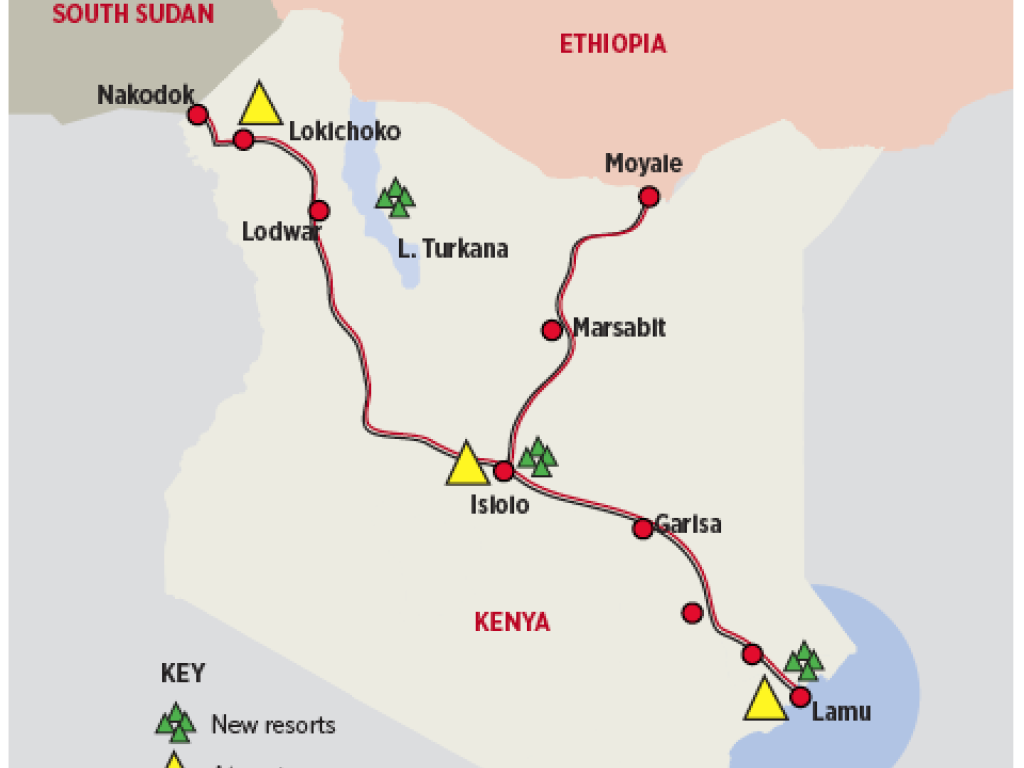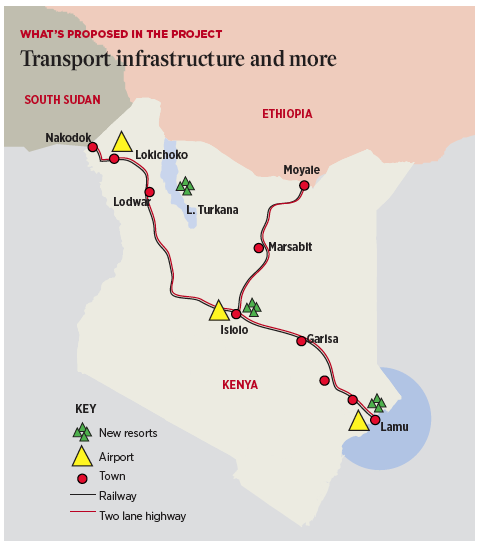Synergies and tensions of development interventions and climate change adaptation activities for pastoral livelihoods

By Amos Wemanya - MSc. Climate change and International Development, University of East Anglia, UK.
In Kenya, pastoral livelihoods have constantly adapted to natural climatic variations, but the increasing frequency and magnitude of climate related risks and impacts – such as droughts and floods – may push pastoralists beyond their capacity to cope and adapt1. In this article I describe the synergies and tensions of development interventions and climate adaptation activities in the context of pastoral livelihoods. The article draws on my dissertation research where I explored the potential influence of Kenya’s Lamu Port South Sudan Ethiopia Transport (LAPSSET) corridor development project on the resilience of pastoral livelihoods to climate stresses.
The LAPSSET corridor is a major infrastructural development project that will run from the Kenyan coast to South Sudan and Ethiopia. It is a crucial Kenya Vision 2030 Flagship Project and forms Kenya’s second Transport and Economic development corridor. The LAPSSET corridor was established to transport oil from South Sudan through the port of Lamu in Kenya to international markets and boost regional economic growth2. But, since much of the project infrastructure will pass through the pastoral rangelands, it could help to bring much needed economic development to some of Kenya’s most historically marginalised arid and semi-arid lands (ASAL). This could simultaneously build the resilience of pastoralists to the impacts of climate stresses. However, there are also strong reasons to question whether such benefits will, in fact, arise.
In my study I used the sustainable livelihoods framework to understand how the LAPSSET corridor project has taken into account pastoralists’ access to asset capitals and how this may influence pastoral livelihoods’ resilience to climate stresses in the Kenyan ASALs. I conducted my research in an area of the Isiolo County, collecting data through interviews with pastoralists and key informants, and document analysis.

Map showing LAPSSET corridor project location activities in Kenya (Source: Map by Daily Nation, July 23, 2011)
Social capital
Over many years Isiolo pastoralists have developed systems of customary resource management. Under these systems, community elders primarily control the access and exploitation of their community’s resources. My interviews with the key informants suggested that the LAPSSET corridor project’s support for settled agriculture and livestock rearing may encourage private land ownership tenures, which would weaken traditional community resource management arrangements. It is possible that development interventions that seek to give power to a few individuals may weaken the capacity of existing social institutions to collectively contribute to building societal resilience to climate stresses3.
In Isiolo, many pastoralists are deeply concerned about the influx of non-pastoralists implied in the LAPSSET corridor project plans. To the pastoralists, these ‘outsiders’ may introduce new challenges and competition to the pastoral region’s already limited resources of water and rangeland. Studies by previous scholars4 show that pastoral cultures, land tenure systems and institutions have been modified as a result of the influence of external interests. Some ‘outsiders’ interests may support sedentarisation activities. My findings and those of others suggest that pastoral rangelands are commonly portrayed as idle pieces of land that can be used for irrigated agriculture and other sedentary economic growth ventures5. Sedentarisation activities may limit pastoralist’s access to and exploitation of the resources that are necessary for building resilience against climate stresses6.
Natural capital
Many studies have shown that mobility makes pastoralism highly adaptable to harsh environmental conditions and climate variability of the arid and semi-arid regions7. In Isiolo, pastoralists are apprehensive that sedentarisation may lead to the creation of rangeland enclosures by local elites or ‘outsiders’, which would prevent them from accessing the more productive areas of land. Additionally, such enclosures may fringe livestock migratory routes, and impede the access of pastoralist to the biodiversity resources vital for their livelihood productivity8. Sedentary rangeland production activities have also been associated with various environmental challenges in drylands including adverse impacts on water cycles and the hydrological function of soils9.

Pastoralists moving with animals in search of pasture and water in Isiolo County (Photo: Amos Wemanya)
Human capital
By attracting new investment opportunities and skill pools to the Isiolo area, the LAPSSET corridor project could increase the resilience of pastoral livelihoods to climate stresses. Additionally, the establishment of scholarship schemes for pastoral community students (an activity that is implied in the LAPSSET corridor project plans) may help to develop the local skillsets. However, there is a need to innovate within pastoral education systems in order to accommodate the mobile nature of pastoral livelihoods. The current sedentary schooling facilities in pastoral regions tend to be out of step with the practice of mobile pastoralism – a practice that grants pastoralists access to critical production resources such as water and pasture10.
CONCLUSION
Given its proposed activities, the LAPSSET corridor project could provide increased opportunities to build resilience to climate stresses if it adequately involves pastoralists in its planning and implementation processes and supports the continuation of the flexible resource access arrangements required by their extensive livestock production system. However, as was clear from my interviews with the pastoralists in Isiolo, the LAPSSET corridor project’s relatively weak engagement of pastoralists during its planning processes means that many of the pastoralist’s concerns about their continued access to and use of critical asset capitals have not been adequately taken into account. Contrary to what is necessary, this may compromise their resilience to climate stresses in Isiolo.
1 Osbahr, H., (2007): Building resilience: Adaptation mechanisms and mainstreaming for the poor. Background paper for UNDP Human Development report
2 Kasuku, S. (2013): Building Africa’s Transformative and Game changer Infrastructure to deliver a Just and prosperous Kenya, LAPSSET Corridor Development Authority presentation during Kenya-UK investment conference, London.
3 Goulden, M. (2006): Livelihood diversification, social capital and resilience to climate variability amongst natural resource dependent societies in Uganda, PhD thesis University of East Anglia.
4 Nori, M., Taylor, M., and Sensi, T. (2008): Browsing on fences: Pastoral land rights, livelihoods and adaptation to climate change, Nottingham UK.
5 Catley, A., Lind, J. and Scoones, I. (2013): Development at the margins: Pastoralism in the horn of Africa, In Catley, A., J. Lind, and Scoones, I. (Eds.) Pastoralism and development in Africa: Dynamic change at the margins. Routledge, London and Newyork.
6 Niamir-Fuller F. 1998: The resilience of pastoral herding in Sahelian Africa. In: Berkes F., Folke C. and Colding J. (Eds.), Linking social and ecological systems: Management practices and social mechanisms for building resilience. Cambridge University Press, Cambridge, UK
7 Lepakana, L. P. (2013): Socio-economic impacts of droughts on pastoralists, their coping strategies, and government interventions in Marsabit County, Kenya, Masters Thesis, Centre for Advanced Studies in Environmental Law and Policy (CASELAP) University of Nairobi.
8 Babiker, M. (2013): Mobile pastoralism and land grabbing in Sudan: impacts and responses, In Catley, A., J. Lind, and Scoones, I. (Eds.) Pastoralism and development in Africa: Dynamic change at the margins. Routledge, London and Newyork.; Napier, A., andDesta, S. (2011): Review of pastoral rangeland enclosures in Ethiopia. PLI policy project
9 McGahey, D., Davies, J., Hagelberg, N., and Ouedraogo, R., 2014. Pastoralism and the Green Economy – a natural nexus? Nairobi: IUCN and UNEP. x + 58p
10 Little, D.P., Aboud, A.A. and Lenachuru, C. (2009): Can formal education reduce risks for drought prone pastoralists? A case from Baringo district, Kenya, Human organization 68(2): 154-165